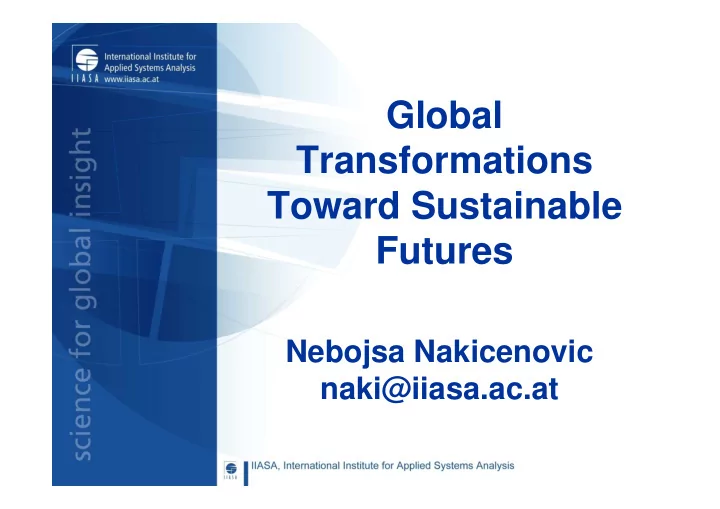

Global Transformations Toward Sustainable Futures Nebojsa Nakicenovic naki@iiasa.ac.at
Professor Howard Raiffa
IIASA Directors 1972-1975 Professor Howard Raiffa 1975-1981 Dr. Roger Levien 1981-1984 Professor C.S. Holling 1984-1987 Professor Thomas H. Lee † 1987-1990 Dr. Robert H. Pry † 1990-1996 Dr. Peter E. de Jánosi † 1996-2000 Professor Gordon J. MacDonald † 2000-2002 Professor Arne B. Jernelöv 2002-2008 Professor Leen Hordijk 2008-2009 Professor Sten Nilsson 2009-2012 Professor Detlof von Winterfeldt 2012- Professor Pavel Kabat
Global Transformations Years before present 10 11 10 10 10 9 People 10 8 10 7 Hunter-Gatherer 10 6 10 6 10 5 10 4 10 3 10 2 10 1 10 0 Source: Kates, 1997; Deevey, 1960
Global Transformations Neolithic Revolution Years before present 10 11 10 10 10 9 People 700 Million 1700 A.D. Neolithic 10 8 10 7 7 Million 5000 B.C. Hunter-Gatherer 10 6 10 6 10 5 10 4 10 3 10 2 10 1 10 0 Source: Kates, 1997; Deevey, 1960
Global Transformations Neolithic and Industrial Revolutions Years before present 10 11 Industrial 10 10 7,000 Million 10 9 People 700 Million 1700 A.D. Neolithic 10 8 10 7 7 Million 5000 B.C. Hunter-Gatherer 10 6 10 6 10 5 10 4 10 3 10 2 10 1 10 0 Source: Kates, 1997; Deevey, 1960
Global Transformations Anthropocene - Toward Sustainability Years before present after present 10 11 Anthropocene Industrial 12.5 Billion 10 10 7,000 Million 5 Billion Sustainability 10 9 People 700 Million 1700 A.D. Neolithic 10 8 10 7 7 Million 5000 B.C. Hunter-Gatherer 10 6 10 6 10 5 10 4 10 3 10 2 10 1 10 0 10 1 10 2 Source: Kates, 1997; Deevey, 1960; Lutz & Scherbov, 2007; 2008
Transformation Drivers Learning from the Past � Normative goals, visions Abolition of slavery, participatory governance, EU � Crises, “gales of creative destruction” The Great Depression, financial crises, disasters � Technology, rapid innovation diffusion Substitution of carriages by cars, IT-revolution � Knowledge, research-driven society Precautionary principle - ozone layer, climate change Source: Grubler, 2000; WBGU, 2011
Global Educational Attainment 100% 80% Primary Education+ 60% Population Secondary Education+ 40% 20% 0% 1850 1900 1950 2000 2050 2100 Source: Lutz et al., 2007
Participatory Governance 100% 80% Participatory 60% Population 40% 20% 0% 1850 1900 1950 2000 2050 2100 Source: Modelski & Perry, 2008; 2010
Participatory Governance Slavery Abolishment 100% Abolishment 80% 1948 UN Declaration Participatory 1906 of Human Rights China 60% Population 40% 1863 United States 20% of America 0% 1850 1900 1950 2000 2050 2100 Source: Nakicenovic & Rogner, 2012; Modelski & Perry, 2002; 2010
Urbanization World 100% IIASA SRES A2r scenario 80% IIASA SRES B1 scenario 60% Population IIASA SRES B2 scenario Historical (UN) 40% 20% 0% 1850 1900 1950 2000 2050 2100 Source: Nakicenovic et al., 2000; Riahi et al., 2007; Grubler et al. 2012
Urbanization World, UK, BRICs 100% UK IIASA SRES A2r scenario 80% IIASA SRES B1 scenario 60% Population IIASA SRES B2 scenario Historical (UN) 40% BRICs 20% 0% 1850 1900 1950 2000 2050 2100 Source: Nakicenovic et al., 2000; Riahi et al., 2007; Grubler et al. 2012
Transformation of Energy Systems One of 41 GEA Pathways 100% 80% GRIDS Final Energy 60% LIQUIDS 40% SOLIDS 20% 0% 1850 1900 1950 2000 2050 2100 Source: Global Energy Assessment, 2012
IIASA Research Strategy Food & Water Energy Poverty & & Climate Equity Change
IIASA Research Strategy Food & Water Energy Poverty & & Climate Equity Change
IIASA Research Strategy Food & Water Energy Poverty & & Climate Equity Change
IIASA Research Strategy Food & Water Energy Poverty & & Climate Equity Change
IIASA Research Strategy Food & Water Energy Poverty & & Climate Equity Change
Vision of a Sailing Monorail Proposed by Henry R. Palmer in 1824 Source: Register of Arts and Sciences, 1824
Recommend
More recommend